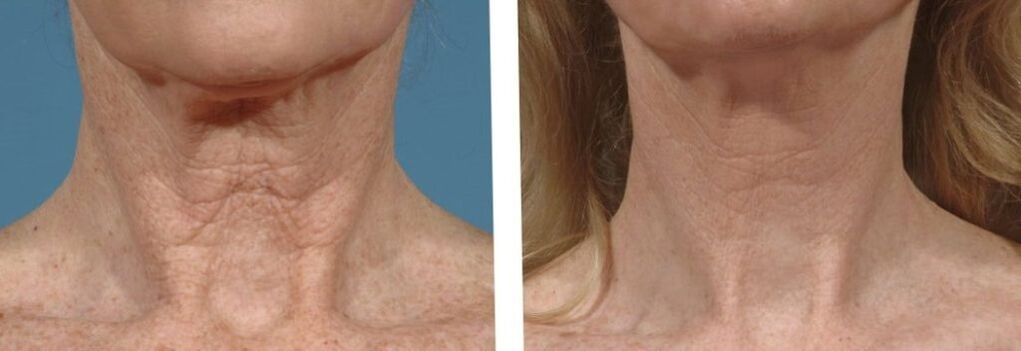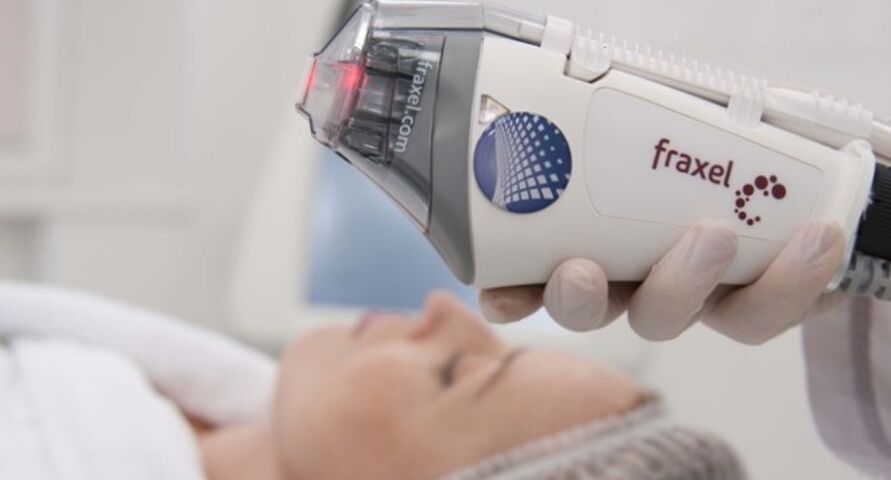Fractional photothermolysis is an effective means of modern cosmetology that allows you to fight aging, skin laxity, as well as its defects: scars, wrinkles and pigmentation; without surgical intervention. Moreover, dermal optical thermolysis allows, in some cases, to avoid the rehabilitation period, returning the patient to active activity the very next day after therapy.
Scope of fractional photothermolysis technology
The technique of point dot rejuvenation extends to all areas of the skin, including even traditionally prohibited areas: eyelids, corners of the eyes, neck and décolleté. In fact, complete facial rejuvenation is achieved. That is, there are no zones that are inaccessible for processing due to any reason.
In addition, the technology allows for such specific skin care as intimate rejuvenation, and also contributes to the following processes:
- complete disappearance of scars, stretch marks and fine wrinkles;
- narrowing of overly enlarged pores;
- smoothing deep folds;
- elimination of pigmentation, general alignment of skin tone.
Additional advantages of fractional thermolysis: rapid wound healing and a wide age range, covering an audience from 25 to 70 years.

The essence of the technique
The main concept of fractional laser thermolysis technology is a point effect on skin tissues, when cell damage over the entire area is replaced by a dot procedure. This makes it possible to reduce the amount of dermal damage: from 4 to 48% of cells undergo light destruction. The exact figure depends on the type of therapy.
By the nature of the impact, laser ablation is distinguished - a process accompanied by the release of cellular substance from the skin and a non-ablative approach. In the second case, fractional photothermolysis is carried out at a depth, leaving no open wounds, which significantly reduces the time for their healing. The disadvantage of this approach is a lower level of lifting than with ablation.
The main equipment operated by dermal optical thermolysis is lasers, usually gas CO2 or fiber systems, where the generation of radiation is activated by erbium or thulium. The thulium laser is especially effective, since the wavelength of its radiation is close to the maximum absorption of water. An important feature of all laser systems that use fractional photothermolysis is their operation in the infrared range. This allows the radiation to penetrate deep into the skin to the lower layers of the epidermis and dermis, without damaging the protective cornea.
Another important feature of dot therapy is partial cell damage. In fact, coagulation microchannels are formed in the skin, which are isolated from each other by healthy areas. Their size does not exceed 0. 2 mm, and the depth varies from a tenth to one and a half millimeters. The appearance of damaged areas activates the production of the following substances by the body:
- hyaluronic acid involved in the regeneration of skin tissues;
- fibrillar protein - collagen, which helps to smooth the skin, due to the creation of a moisture-retaining layer on its surface;
- elastin, which provides the mechanical strength of the skin, its firmness and elasticity.
Thus, the main advantages that fractional thermolysis dot therapy has are:
- Slight inflammatory response.
- Fast recovery. Skin healing does not exceed three days, and in most cases a day.
- There is no risk of infection as there are no open wounds. The horny protective layer of the skin remains intact.
These factors led to the development of fractional photothermolysis technology, which in 2004 led to the creation of a specialized Fraxel apparatus.

Fraxel - innovative equipment for laser rejuvenation
In fact, Fraxel is a device for dot therapy. Reliant's latest development combines two fiber lasers:
Erbium. With its help, classic non-ablative laser resurfacing is performed. The laser forms deep microscopic treatment zones up to 1. 4 mm, resulting in subsequent remodeling of the reticular layer of the dermis. This helps to improve the relief characteristics of the skin: smoothing wrinkles, eliminating scars.
Thulium. The impact of this laser is limited to the epidermis layer, which corresponds to a low level of radiation penetration depth: no more than 0. 2 mm. The result is the removal of unwanted pigment. For example, exposure to a thulium laser allows for a couple of procedures to solve the problem of actinic keratosis - roughening of the skin caused by prolonged exposure to the sun.
The second laser used by Fraxel allows solving two different types of problems in one session: elimination of defects on the skin and rejuvenation of the face and other parts of the body.
Procedure and recovery period
Skin care through laser thermolysis - Fraxel, includes a preparatory stage, a direct session, as well as rehabilitation. The procedure itself precedes the examination of the skin and the choice of anesthesia. As a rule, a special cream is applied to the area, then you need to wait about an hour. The next preparatory element is a soft pink peeling. It allows you to remove dead cells.
The very procedure of fractional skin rejuvenation can be performed with a laser: CO2, DECA type or fiber; depending on the goal of therapy. Each area of the skin corresponds to special nozzles that differ in shape and size. The duration of the session takes about the same time as waiting after treatment with anesthetic ointment, that is, about an hour. The final stage is the care of the treated area. A soothing cream with an antiseptic effect is applied to it.
The consequences of therapy can be expressed in reddening of the skin, acquiring a bronze hue to it, sometimes itching, burning and pain. As a rule, all discomfort disappears in the first three days after the procedure. With intensive exposure to complete wound healing, it may take a week.
To promote a speedy recovery, it is recommended to follow simple rules:
- Avoid exposure to direct sunlight;
- give up walking in windy weather, swimming in open water;
- do not use decorative cosmetics, abrasive cleansers, scrubs.
Skin care should include moisturizers morning and night. It is also recommended to wash with exceptionally soft water. Contribute to the fastest recovery will be eating vitamin-containing foods: vegetables, herbs and fruits.
Contraindications
Like any medical technique, fractional thermolysis has its limitations. The procedure is contraindicated for pregnant and lactating women, as well as persons suffering from:
- oncology;
- diabetes mellitus;
- acute manifestations of chronic ailments, herpes;
- cardiovascular insufficiency;
- poor blood clotting.
Tanning can be additional obstacles to the passage of rejuvenation dot: natural and in a solarium. Also, contraindications include inflammatory processes or neoplasms on the skin and chemical peeling made within six months.
The cost of therapy
Without going into details of the exact prices for fractional skin rejuvenation, we can point out the most expensive procedures. These include intimate rejuvenation, thigh areas, as well as treatment of the entire face. The average price level is set for the areas of the neck, perioral region, shoulders, knees and hands. The most budgetary procedures are associated with areas of the upper lip, temporal region and scar correction.
conclusions
According to patient reviews, the Fraxel device and its effect on the skin is not a fiction or a myth. Laser fractional thermolysis will allow for several sessions to rejuvenate the skin, remove pigment, scar or scar on it. This method is also needed for the general alignment of skin color. The absence of a rehabilitation period in many cases, as well as the safety of the Fraxel technique, the constant improvement of both the device itself and the technology are the main criteria in favor of its choice.






















